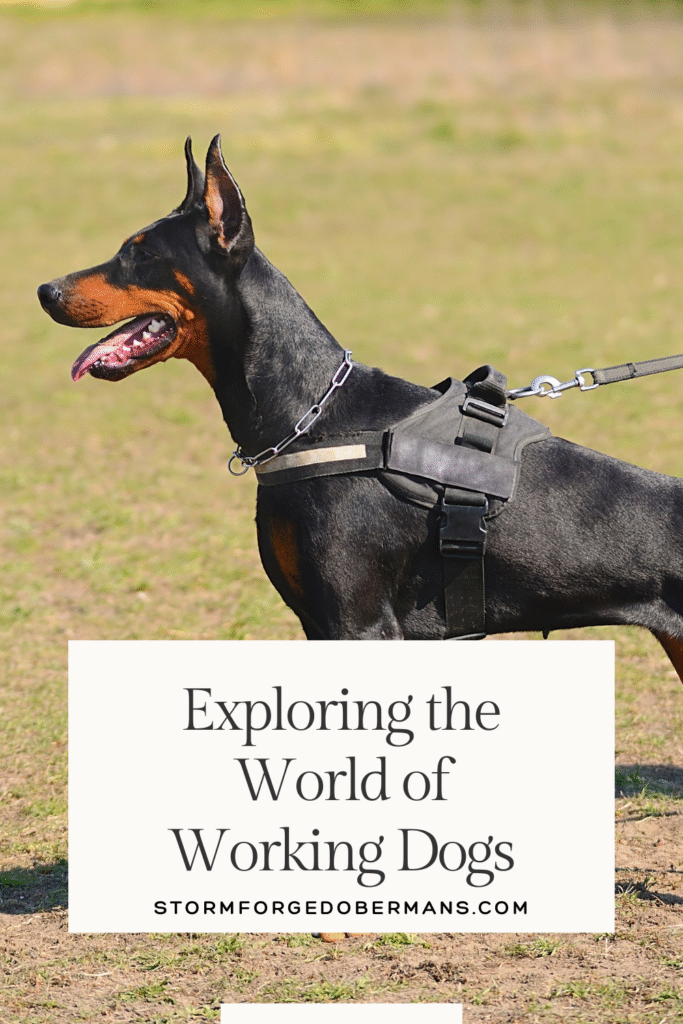Working dogs have long been revered for their specialised skills and contributions in various fields. Among the myriad breeds used for work, the Doberman stands out due to its versatility and capabilities.
Beyond Dobermans, many other breeds excel as working dogs. The Belgian Malinois and German Shepherd are staples in police and military roles worldwide due to their intelligence and agility. For powerful guarding, breeds like the Rottweiler and Akita stand out. Herding breeds such as the Border Collie and Australian Cattle Dog showcase incredible stamina and focus, excelling in livestock management. Versatile breeds like the Dutch Shepherd and Giant Schnauzer also make excellent working companions.
This post will explore the different types of working dogs, focusing particularly on Dobermans, while also comparing them to other prominent working breeds.
Doberman
The Doberman is a breed renowned for its intelligence, agility, and loyalty. Developed in Germany in the late 19th century by tax collector Louis Dobermann, the Doberman was originally designed to accompany him on his rounds and provide protection.
Today, Dobermans are recognized for their versatility and are employed in various roles including police work, military service, search and rescue, and competitive obedience.
Strengths:
- Versatility: Dobermans are highly adaptable and can be trained for a variety of tasks, from protection to detection and assistance roles. Their ability to switch between different types of work makes them highly valuable in numerous settings.
- Intelligence: Dobermans are known for their sharp intelligence, which enables them to excel in complex tasks and learn commands quickly. This trait makes them ideal for roles that require quick thinking and problem-solving.
- Loyalty and Bonding: One of the most notable characteristics of Dobermans is their strong loyalty to their families. They form deep bonds with their owners, which enhances their effectiveness as personal protection and service dogs.
- Physical Abilities: Dobermans are robust and athletic, with a strong build that supports their physical tasks. They are agile and have high endurance, making them suitable for demanding work environments.
Challenges:
- High Energy and Exercise Needs: Dobermans require significant physical exercise and mental stimulation to stay healthy and happy. Without adequate activity, they may become bored or restless, leading to behavioral issues.
- Guarding Instincts: While their protective nature is a strength, it can also be a challenge if not properly managed. Dobermans need consistent training to ensure their guarding instincts are balanced and appropriate for their environment.
Notable Achievements: Dobermans have made significant contributions in various fields. In police and military roles, they have been instrumental in detecting explosives, apprehending suspects, and providing security. Their keen senses and quick reactions make them invaluable in search and rescue missions, where they help locate missing persons or disaster survivors. Dobermans have also excelled in competitive obedience, showcasing their trainability and precision.
German Shepherd
Overview: German Shepherds are one of the most recognized working breeds worldwide, initially developed for herding. They are now widely used in police work, military service, search and rescue, and as guide dogs for the visually impaired.
Strengths:
- Work Ethic: German Shepherds are known for their strong work ethic and reliability in demanding roles.
- Training: They are highly trainable and excel in obedience and specialized tasks.
- Adaptability: This breed adapts well to various working environments.
Challenges:
- Health Issues: German Shepherds can be prone to hip and elbow dysplasia.
- Socialization Needs: They require proper socialization to ensure balanced behavior.
Belgian Malinois
Overview: The Belgian Malinois is often compared to the German Shepherd due to its similar working abilities. This breed is commonly used in police and military roles, as well as in search and rescue operations.
Strengths:
- Drive: Belgian Malinois possess a strong drive and high energy levels, making them excellent for high-intensity tasks.
- Agility: They are highly agile and excel in tasks requiring quick movements and precision.
- Focus: Their intense focus and work ethic make them outstanding in detection and protection work.
Challenges:
- High Maintenance: Their high energy levels require significant exercise and mental stimulation.
- Independent Nature: Their strong drive can sometimes lead to stubbornness.
Labrador Retriever
Overview: Labrador Retrievers are one of the most popular working dogs due to their friendly nature and versatility. They are often employed as guide dogs, search and rescue dogs, and in detection work.
Strengths:
- Temperament: Labradors are known for their friendly and outgoing nature, making them great for roles involving public interaction.
- Trainability: They are highly trainable and eager to work.
- Versatility: Labradors excel in various roles, from assistance to detection.
Challenges:
- Exercise Needs: They require regular physical activity to prevent obesity and maintain health.
- High Energy: Their high energy can be challenging if not properly managed.
Rottweiler
Overview: Rottweilers are known for their strength and guarding abilities. Originally used for herding and as guard dogs, they are now employed in protection work and search and rescue.
Strengths:
- Strength: Rottweilers have exceptional physical strength and endurance.
- Guarding Instincts: They are natural protectors and excel in security roles.
- Loyalty: Rottweilers are loyal and form strong bonds with their families.
Challenges:
- Socialisation: They require proper socialization to ensure balanced behavior.
- Training: Consistent, firm training is needed to manage their strong-willed nature.
Border Collie
Overview: Border Collies are widely regarded as the most intelligent and energetic herding breed. They thrive in environments that require constant mental and physical activity.
Strengths:
- Intelligence: Quick learners with an exceptional ability to problem solve.
- Work Ethic: Tireless workers, especially skilled in herding and agility.
- Trainability: Highly responsive to training and commands.
Challenges:
- High Energy: Needs daily intensive exercise and mental stimulation.
- Sensitivity: Can develop anxiety or destructive behaviour if under-stimulated.
- Socialisation Needs: Requires early socialisation to manage prey drive.
Australian Cattle Dog
Overview: Bred for herding cattle in tough Australian environments, these dogs are strong, resilient, and hardworking.
Strengths:
- Endurance: Exceptional stamina and toughness in harsh conditions.
- Intelligence: Problem solvers who excel at independent work.
- Loyalty: Deeply attached to their handlers.
Challenges:
- High Energy: Needs plenty of exercise and purposeful work.
- Independence: Can be stubborn or strong-willed.
- Socialisation Needs: Early socialisation is important to curb aggression.
Giant Schnauzer
Overview: The Giant Schnauzer is a large, intelligent working dog originally bred for guarding and police work.
Strengths:
- Protective: Naturally suspicious of strangers, excellent guard dogs.
- Intelligent: Quick learners with high trainability.
- Energetic: Thrive on regular work and mental challenges.
Challenges:
- Exercise: Requires substantial daily activity.
- Socialisation: Needs early, ongoing socialisation to prevent territorial aggression.
- Grooming: Requires regular coat maintenance.
Dutch Shepherd
Overview: Dutch Shepherds are versatile working dogs known for police, search and rescue, and herding roles.
Strengths:
- Adaptability: Easily adjust to different working environments.
- Intelligence: Quick to learn and highly trainable.
- Loyalty: Strong bonds with handlers.
Challenges:
- Exercise Needs: Require lots of physical and mental stimulation.
- Socialisation Needs: Early socialisation necessary to prevent over-guarding.
- Sensitivity: Respond best to positive training methods.
Final Thoughts on Selecting the Best Working Dog Breed
When comparing Dobermans to other working breeds, it becomes clear that each breed has its unique strengths and challenges. Dobermans stand out for their versatility, intelligence, and loyalty, making them well-suited for a wide range of tasks.
German Shepherds and Belgian Malinois are also highly versatile and excel in intense working environments, while Labrador Retrievers offer a more friendly and adaptable nature. Rottweilers bring strength and guarding capabilities to the table but require proper training and socialisation.
Choosing the right working dog depends on the specific needs of the job and the characteristics that best fit the role. Whether it’s the adaptability of the Doberman, the drive of the Belgian Malinois, or the friendly nature of the Labrador Retriever, understanding the strengths and challenges of each breed helps in selecting the ideal working dog for your requirements.
For readers seeking more detailed information on working dog breeds and their roles, the Australian National Kennel Council (ANKC) provides official breed standards and comprehensive dog information relevant to Australian enthusiasts. The Working Dog Association Australia offers valuable resources specifically tailored to working dogs in Australia, while the Australian Working Kelpie Council focuses on one of the country’s premier herding breeds. For broader international perspectives, the American Kennel Club (AKC) Working Group features detailed breed descriptions and standards, and the International Working Dog Registry offers a global registry for working dog lines. Additionally, for health-related information, the Orthopedic Foundation for Animals (OFA) is a trusted source covering genetic health conditions in many working breeds.
Ready to find your perfect working dog? Explore our expert guides or join our mailing list for tailored tips and breed advice!

